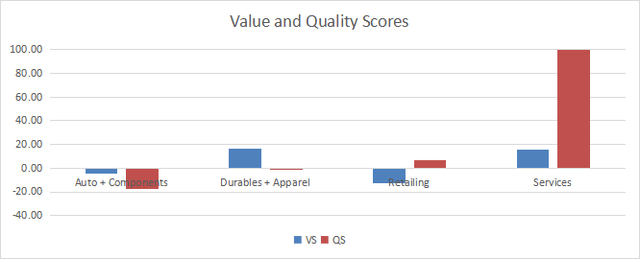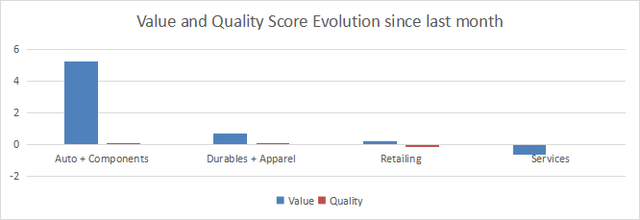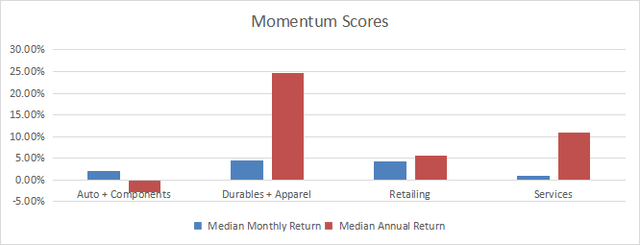MediaProduction
This monthly article series shows a dashboard with aggregate subsector metrics in consumer discretionary. It is also a top-down analysis of sector exchange-traded funds, or ETFs, like Consumer Discretionary Select Sector SPDR® Fund ETF (XLY) and Fidelity® MSCI Consumer Discretionary Index ETF (NYSEARCA:FDIS), whose largest holdings are used to calculate these metrics.
Shortcut
The next two paragraphs in italic describe the dashboard methodology. They are necessary for new readers to understand the metrics. If you are used to this series or if you are short of time, you can skip them and go to the charts.
Base Metrics
I calculate the median value of five fundamental ratios for each subsector: Earnings Yield (“EY”), Sales Yield (“SY”), Free Cash Flow Yield (“FY”), Return on Equity (“ROE”), Gross Margin (“GM”). The reference universe includes large companies in the U.S. stock market. The five base metrics are calculated on trailing 12 months. For all of them, higher is better. EY, SY and FY are medians of the inverse of Price/Earnings, Price/Sales and Price/Free Cash Flow. They are better for statistical studies than price-to-something ratios, which are unusable or non available when the “something” is close to zero or negative (for example, companies with negative earnings). I also look at two momentum metrics for each group: the median monthly return (RetM) and the median annual return (RetY).
I prefer medians to averages because a median splits a set in a good half and a bad half. A capital-weighted average is skewed by extreme values and the largest companies. My metrics are designed for stock-picking rather than index investing.
Value and Quality Scores
I calculate historical baselines for all metrics. They are noted respectively EYh, SYh, FYh, ROEh, GMh, and they are calculated as the averages on a look-back period of 11 years. For example, the value of EYh for retailing in the table below is the 11-year average of the median Earnings Yield in retail companies.
The Value Score (“VS”) is defined as the average difference in % between the three valuation ratios ((EY, SY, FY)) and their baselines (EYh, SYh, FYh). The same way, the Quality Score (“QS”) is the average difference between the two quality ratios ((ROE, GM)) and their baselines (ROEh, GMh).
The scores are in percentage points. VS may be interpreted as the percentage of undervaluation or overvaluation relative to the baseline (positive is good, negative is bad). This interpretation must be taken with caution: the baseline is an arbitrary reference, not a supposed fair value. The formula assumes that the three valuation metrics are of equal importance. A floor of -100 is set for VS and QS when the calculation goes below this value. It may happen when metrics in a subsector are very bad.
Current Data
The next table shows the metrics and scores as of last week’s closing. Columns stand for all the data named and defined above.
|
VS |
QS |
EY |
SY |
FY |
ROE |
GM |
EYh |
SYh |
FYh |
ROEh |
GMh |
RetM |
RetY |
|
|
Auto + Components |
-4.77 |
-17.46 |
0.0659 |
1.1480 |
0.0372 |
13.25 |
20.97 |
0.0604 |
1.4539 |
0.0381 |
18.54 |
22.40 |
2.05% |
-2.74% |
|
Durables + Apparel |
16.66 |
-0.52 |
0.0567 |
0.7350 |
0.0476 |
22.69 |
35.83 |
0.0533 |
0.7123 |
0.0339 |
18.81 |
45.71 |
4.38% |
24.58% |
|
Retailing |
-12.54 |
7.13 |
0.0524 |
0.5426 |
0.0348 |
30.59 |
34.76 |
0.0490 |
0.8251 |
0.0388 |
26.00 |
35.97 |
4.23% |
5.58% |
|
Services |
15.89 |
109.53 |
0.0375 |
0.3479 |
0.0272 |
42.73 |
41.56 |
0.0307 |
0.3978 |
0.0197 |
14.14 |
35.58 |
1.00% |
10.93% |
Value and Quality Chart
The next chart plots the Value and Quality Scores by subsector (higher is better).
Value and quality in consumer discretionary (Chart: author; data: Portfolio123)
Evolution Since Last Month
The value score has improved in the auto and components subsector.
Variations in value and quality (Chart: author; data: Portfolio123)
Momentum
The next chart plots momentum scores based on median returns.
Momentum in consumer discretionary (Chart: author; data: Portfolio123)
Interpretation
According to my monthly S&P 500 dashboard, the consumer discretionary sector is overvalued by about 8% relative to 11-year averages. Nevertheless, the durables and apparel and consumer services subsectors are undervalued by about 16% using the same metrics. Moreover, consumer services have an excellent quality score. Auto/components and retailing are moderately overpriced, but the former has the lowest quality score in the sector.
FDIS Fast Facts
Fidelity® MSCI Consumer Discretionary Index ETF has been tracking the MSCI USA IMI Consumer Discretionary 25/50 Index since 10/21/2013. It has a total expense ratio of 0.08%, a bit cheaper than XLY (0.10%).
The fund has 292 holdings. The top 10 holdings, listed in the next table, represent 59.3% of the fund’s asset value. Over 35% of assets is concentrated in the top 2 names, Amazon and Tesla.
|
Ticker |
Name |
Weight% |
EPS growth %TTM |
P/E TTM |
P/E fwd |
Yield% |
|
Amazon.com, Inc. |
21.70 |
75.88 |
80.73 |
57.53 |
0 |
|
|
Tesla, Inc. |
13.56 |
-4.04 |
70.48 |
71.34 |
0 |
|
|
The Home Depot, Inc. |
6.67 |
-6.08 |
22.82 |
23.61 |
2.35 |
|
|
McDonald’s Corp. |
4.15 |
42.98 |
25.86 |
24.88 |
2.28 |
|
|
NIKE, Inc. |
2.57 |
-3.29 |
30.68 |
29.07 |
1.41 |
|
|
Lowe’s Companies, Inc. |
2.53 |
27.17 |
16.87 |
16.81 |
2.01 |
|
|
Booking Holdings, Inc. |
2.50 |
135.76 |
24.39 |
23.78 |
0 |
|
|
Starbucks Corp. |
2.12 |
26.47 |
25.67 |
22.30 |
2.48 |
|
|
The TJX Cos., Inc. |
2.08 |
23.13 |
26.91 |
25.32 |
1.40 |
|
|
MercadoLibre, Inc. |
1.37 |
266.44 |
84.26 |
73.18 |
0 |
Ratios: Portfolio123.
FDIS has outperformed XLY by about 25% in total return since inception. The gap is much less impressive in annualized return: only 86 bps. The risk measured in maximum drawdown and standard deviation of monthly return (“volatility” in the next table) is similar for both funds.
|
Total Return |
Annual. Return |
Drawdown |
Sharpe |
Volatility |
|
|
FDIS |
236.69% |
12.62% |
-39.16% |
0.63 |
20.44% |
|
XLY |
211.31% |
11.76% |
-39.67% |
0.61 |
19.71% |
Data calculated with Portfolio123.
In summary, FDIS is a good product with cheap management fees for investors seeking capital-weighted exposure in consumer cyclicals. It holds 292 stocks including large, mid- and small caps, whereas XLY has only 55 holdings in larger companies. FDIS has slightly outperformed XLY since 2013.
Fidelity® MSCI Consumer Discretionary Index ETF is a good choice for long-term investors. However, liquidity makes XLY a better instrument for tactical allocation and trading. Investors who are concerned by the weights of the top holdings, especially Amazon, may prefer the Invesco S&P 500 Equal Weight Consumer Discretionary ETF (RSPD).
Dashboard List
I use the first table to calculate value and quality scores. It may also be used in a stock-picking process to check how companies stand among their peers. For example, the EY column tells us that a retail company with an Earnings Yield above 0.0524 (or price/earnings below 19.08) is in the better half of the industry regarding this metric. A Dashboard List is sent every month to Quantitative Risk & Value subscribers with the most profitable companies standing in the better half among their peers regarding the three valuation metrics at the same time. The list below was sent to subscribers several weeks ago based on data available at this time.
|
Guess, Inc. |
|
|
Designer Brands, Inc. |
|
|
Caleres, Inc. |
|
|
Signet Jewelers Ltd. |
|
|
Penske Automotive Group, Inc. |
|
|
Boyd Gaming Corp. |
|
|
MGM Resorts International |
|
|
Dave & Buster’s Entertainment, Inc. |
|
|
Sally Beauty Holdings, Inc. |
It is a rotational model with a statistical bias toward excess returns on the long term, not the result of an analysis of each stock.



